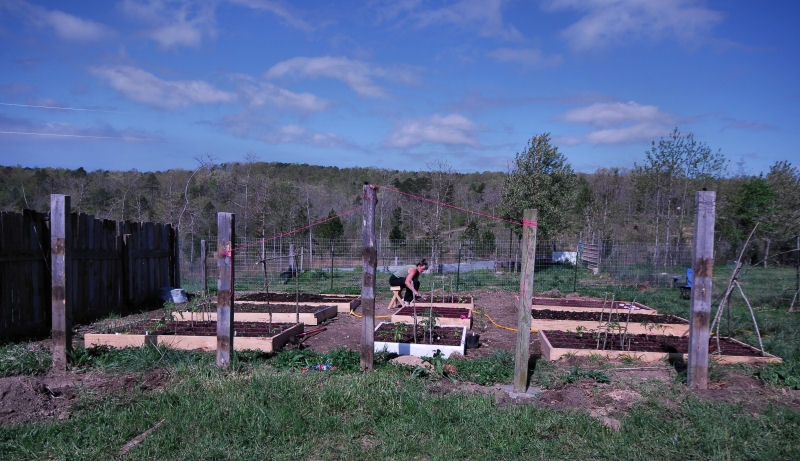I was skeptical at first. I've always planted in rows or mounds with plenty of space between plants.
Starkraven showed me the books and Inet sites, and I felt like it was a great idea for
limited garden space, but since we have mucho space, I felt the crowding would limit growth and production. As you can see from the photos, I was wrong.
The selling point for me was the water conservation aspect of the raised boxes. This area can have several weeks without any rainfall during Summer months, and our
hilltop location is naturally dry. Our water comes from a rather shallow well, and past experience has taught me that wells can be limited during the
dry season. Our emergency plan for drought was to haul water from a nearby river, but it would be a lot of work hauling water up the hill (some here say mountain). I was willing to opt for the raised boxes because I thought it would minimize the water we would have to haul in case of drought.
As it turned out (luckily), our well is spring fed, and my worries about limited water were needless. We have plenty of good tasting, clear spring water for everything. Some of my neighbors are not so lucky, bad smelling water at low flow rates.
The Square Foot Gardens have proved beneficial in other ways.
*Weeding..There was some work involved early. The soil from the chicken/goat yard was loaded with seed and spores. We spent hours in the early days pulling out the little weeds, but after to veggies took off, we really haven't had to weed. The good plants crowd out the weeds. The
raised beds made the weeding easier on the back because we didn't have to lean over so far. We built little stools so we could sit while weeding....no lower back pain! :) Now, the only weed problems we have are on the garden paths. We plan to put down sterile straw or gravel on the paths in the future.
*Staggered Planting...EZ with the little squares, especially for carrots, onions, cilantro, lettuce and radishes. Simply plant a new square every couple of weeks for a continuous
season long staggered harvest of garden fresh veggies. It is easier to keep track of the schedule with the boxes and squares.
*Insect Control...The raised boxes seem to limit or minimize insect damage. We had horned tomato worms in one box, but not the others. Because the boxes are raised and accessible, it was relatively easy to find and pick off the tomato worms. In early Spring we also had some cut worm problems limited to two boxes.
Starkraven treated those two boxes with some organic magic potion...no more cut worms. The boxes present an obsticle to their free movement among the plants. This wouldn't apply to the ones with wings, but so far we haven't had any big problems
*Water Management...Just dig down in one of the corners to determine how dry (or wet) the soil is. Makes it a snap to determine if the plants are getting too much or not enough water. The raised boxes also have a natural resistance to overwatering...it just runs out. We had some heavy rains in June. Most people had problems with tomatoes splitting, but only a few of our tomatoes had minor splits on the tops.
*Support Structures...The plants have produced so much that we have had to add supports for most of the beds. With the raised boxes, it is simple to just fasten support poles to the sides of the boxes with a couple of long screws and a battery powered screwdriver.
*Easier on the Back...The plants are higher so not as much stooping. We are both tall (6') and really appreciate this feature.
*I also have grown to like the cosmetic appeal of the raised box garden. We have outproduced (by far) everybody else in these parts. We feel a little guilty that our garden is so luscious while almost everybody else is having a
bad year. This is probably a combination of several factors in addition to the Raised Square Foot Garden:
--The soil from the abandoned goat/chicken yard is incredibly fertile and
aged just right.
--We haven't had to ration water
--We chose an exposed hilltop that gets more sun than a protected low area. (Starkraven's idea again. I wanted to put the garden in a lower, flatter, more protected place at the bottom of the hill where
most people put their gardens :))
--The windbreaks we laced into the wire on two sides of the garden because of its hilltop location seem to reflect sunlight into the garden. We have both noticed that it is hotter, brighter and more humid inside the windbreaks. We have had a couple of pretty good storms that would have flattened the garden without the windbreaks.
--Bees...our two colonies have obviously increased production. I have never seen so many flowers turn to fruit on a single plant. This is a new thing for us. Neither of us had any previous experience with bees, but they seem to be doing well, and we are fascinated by them. We
learned bees on the Internet.

We are planning on giving some plants more room next year. Some of the boxes became too dense to manage well, and in a couple of cases some of the individual crops were
crowded out. That is probably a product our good luck more than a criticism of the method, but you can tell from my testimony that I am an enthusiastic convert to this method. Hopefully, you can use this to influence any skeptics.
April 2nd Laying out the Garden
We have added 3 more boxes since this photo.